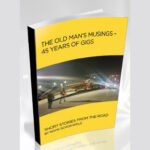The second edition, published in April 2013 and co-authored by scenic designer and Savannah College of Art and Design (SCAD) professor Hal Tiné, still offers guidelines on such nuances as line weight, but as a digital menu option, not a pencil choice.
If the digital era offers many advantages to today’s students — instead of using an eraser, they can simply select an improperly-weighted line and change it with a click — this book gives digital age readers a valuable perspective on the origins of their craft.
The first few chapters of the book, which changed very little from the first edition, explain the importance of the basics — such as picking the right paper and tools for drafting, which could be easily overlooked today.
The book also goes into detail about drafting lines, geometry, hand lettering and dimensioning. All of these skills are just as important today as they have been in the past. Regardless of digital or hand drafting, the importance of presenting a clear and legible design is the main theme of the book.
Professional Applications
The last part of the book has examples of different types of designs used through out the entertainment industry. From theatre, television, films and corporate design, with detailed drawings and renderings from some of the leading lights of Broadway, including George Tyspin (The Little Mermaid), David Gallo (The Drowsy Chaperone) and Christine Jones (American Idiot).
Along with the live stage, the reader will find designs and sketches from other areas within the industry, including the set design of CNN’s Piers Morgan Tonight by James Fenhagen and Sarah Greenwood’s design for the look of the final Tower Bridge scene in the 2009 movie version of Sherlock Holmes.
It’s important to note that, while it covers some of the basics, Patricia Woodbridge never intended either edition of Designer Drafting and Visualizing for the Entertainment World to serve as a strict, by-the-numbers instructional textbook for students.
By offering a “big picture” perspective of the roots of the craft and the current state of the art, however, Woodbridge and Tiné provide today’s digital-age designers a chance to reflect on the value of “thinking with a pencil” and other design fundamentals that might otherwise become a lost art.
New to the Second Edition
›› Updated chapters on the basics
of scenic pencil drafting, including
examples of sketch drafting or
“thinking with a pencil”
›› Drafting from Hollywood and TV hits like True Grit, I Am Legend, Sherlock Holmes, Mr. Popper’s Penguins,
Never Let Me Go, Gossip Girl and more
›› New chapters include Period Shapes
and Scenic Details, Computer Drafting and Illustration, Scenery Graphics,
and Virtual Scenery
Price: $59.95
Pages: 416
Publisher: Focal Press
For more information, go to: http://plsnbookshelf.com/designer-drafting-and-visualizing-for-the-entertainment-world.html


